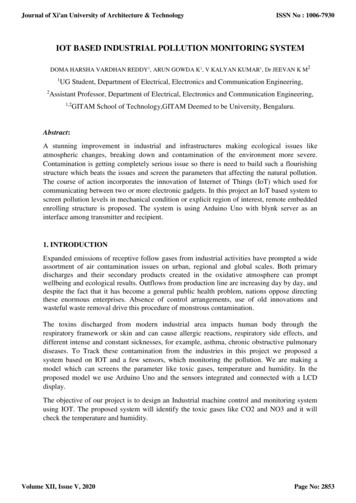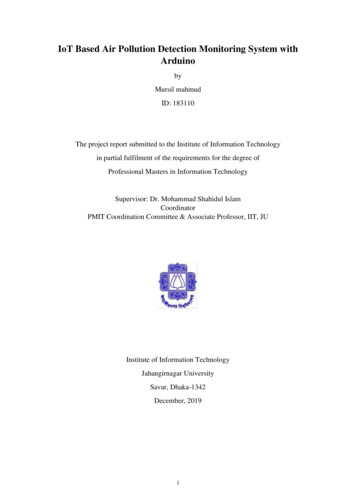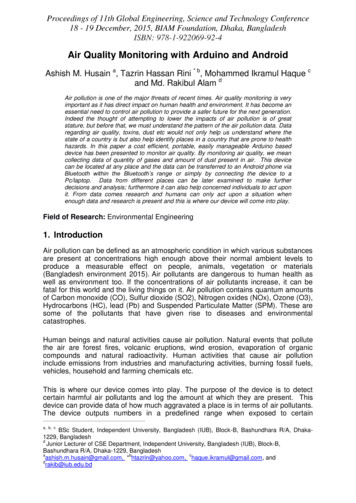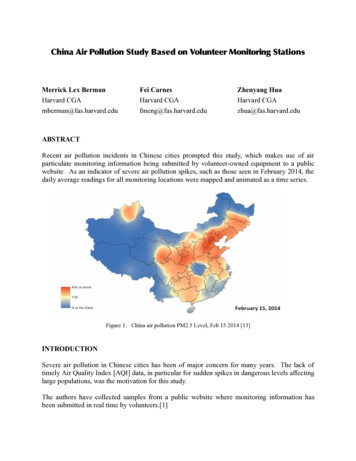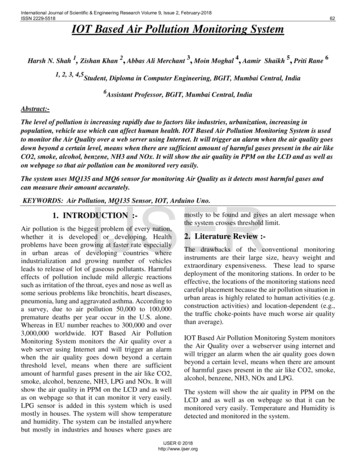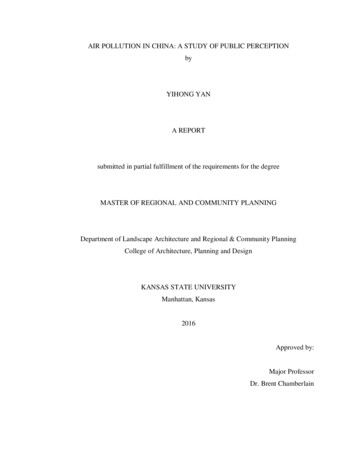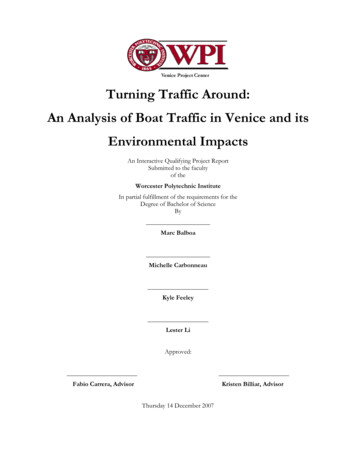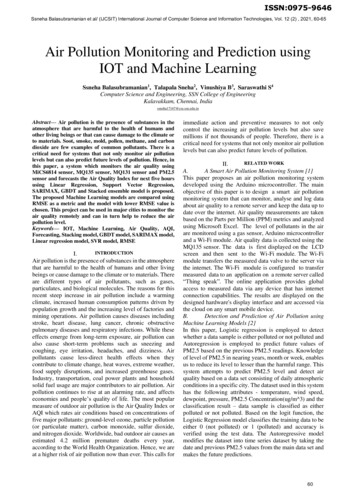
Transcription
ISSN:0975-9646Ssneha Balasubramanian et al/ (IJCSIT) International Journal of Computer Science and Information Technologies, Vol. 12 (2) , 2021, 60-65Air Pollution Monitoring and Prediction usingIOT and Machine LearningSsneha Balasubramanian1, Talapala Sneha2, Vinushiya B3, Saraswathi S4Computer Science and Engineering, SSN College of EngineeringKalavakkam, Chennai, Indiassneha17167@cse.ssn.edu.inAbstract— Air pollution is the presence of substances in theatmosphere that are harmful to the health of humans andother living beings or that can cause damage to the climate orto materials. Soot, smoke, mold, pollen, methane, and carbondioxide are few examples of common pollutants. There is acritical need for systems that not only monitor air pollutionlevels but can also predict future levels of pollution. Hence, inthis paper, a system which monitors the air quality usingMiCS6814 sensor, MQ135 sensor, MQ131 sensor and PM2.5sensor and forecasts the Air Quality Index for next five hoursusing Linear Regression, Support Vector Regression,SARIMAX, GBDT and Stacked ensemble model is proposed.The proposed Machine Learning models are compared usingRMSE as a metric and the model with lower RMSE value ischosen. This project can be used in major cities to monitor theair quality remotely and can in turn help to reduce the airpollution level.Keywords— IOT, Machine Learning, Air Quality, AQI,Forecasting, Stacking model, GBDT model, SARIMAX model,Linear regression model, SVR model, RMSEINTRODUCTIONI.Air pollution is the presence of substances in the atmospherethat are harmful to the health of humans and other livingbeings or cause damage to the climate or to materials. Thereare different types of air pollutants, such as gases,particulates, and biological molecules. The reasons for thisrecent steep increase in air pollution include a warmingclimate, increased human consumption patterns driven bypopulation growth and the increasing level of factories andmining operations. Air pollution causes diseases includingstroke, heart disease, lung cancer, chronic obstructivepulmonary diseases and respiratory infections. While theseeffects emerge from long-term exposure, air pollution canalso cause short-term problems such as sneezing andcoughing, eye irritation, headaches, and dizziness. Airpollutants cause less-direct health effects when theycontribute to climate change, heat waves, extreme weather,food supply disruptions, and increased greenhouse gases.Industry, transportation, coal power plants and householdsolid fuel usage are major contributors to air pollution. Airpollution continues to rise at an alarming rate, and affectseconomies and people’s quality of life. The most popularmeasure of outdoor air pollution is the Air Quality Index orAQI which rates air conditions based on concentrations offive major pollutants: ground-level ozone, particle pollution(or particulate matter), carbon monoxide, sulfur dioxide,and nitrogen dioxide. Worldwide, bad outdoor air causes anestimated 4.2 million premature deaths every year,according to the World Health Organization. Hence, we areat a higher risk of air pollution now than ever. This calls forimmediate action and preventive measures to not onlycontrol the increasing air pollution levels but also savemillions if not thousands of people. Therefore, there is acritical need for systems that not only monitor air pollutionlevels but can also predict future levels of pollution.RELATED WORKII.A.A Smart Air Pollution Monitoring System [1]This paper proposes an air pollution monitoring systemdeveloped using the Arduino microcontroller. The mainobjective of this paper is to design a smart air pollutionmonitoring system that can monitor, analyse and log dataabout air quality to a remote server and keep the data up todate over the internet. Air quality measurements are takenbased on the Parts per Million (PPM) metrics and analyzedusing Microsoft Excel. The level of pollutants in the airare monitored using a gas sensor, Arduino microcontrollerand a Wi-Fi module. Air quality data is collected using theMQ135 sensor. The data is first displayed on the LCDscreen and then sent to the Wi-Fi module. The Wi-Fimodule transfers the measured data valve to the server viathe internet. The Wi-Fi module is configured to transfermeasured data to an application on a remote server called“Thing speak”. The online application provides globalaccess to measured data via any device that has internetconnection capabilities. The results are displayed on thedesigned hardware's display interface and are accessed viathe cloud on any smart mobile device.B.Detection and Prediction of Air Pollution usingMachine Learning Models [2]In this paper, Logistic regression is employed to detectwhether a data sample is either polluted or not polluted andAutoregression is employed to predict future values ofPM2.5 based on the previous PM2.5 readings. Knowledgeof level of PM2.5 in nearing years, month or week, enablesus to reduce its level to lesser than the harmful range. Thissystem attempts to predict PM2.5 level and detect airquality based on a data set consisting of daily atmosphericconditions in a specific city. The dataset used in this systemhas the following attributes - temperature, wind speed,dewpoint, pressure, PM2.5 Concentration(ug/m 3) and theclassification result – data sample is classified as eitherpolluted or not polluted. Based on the logit function, theLogistic Regression model classifies the training data to beeither 0 (not polluted) or 1 (polluted) and accuracy isverified using the test data. The Autoregressive modelmodifies the dataset into time series dataset by taking thedate and previous PM2.5 values from the main data set andmakes the future predictions.60
Ssneha Balasubramanian et al/ (IJCSIT) International Journal of Computer Science and Information Technologies, Vol. 12 (2) , 2021, 60-65C. Air Quality Index and Air Pollutant ConcentrationPrediction Based on Machine Learning Algorithms [3]In this paper, support vector regression (SVR) and randomforest regression (RFR) are used to build regression modelsfor predicting the Air Quality Index (AQI) in Beijing andthe nitrogen oxides (NOX) concentration in an Italian city,based on two publicly available datasets. In this experiment,the AQI of Beijing is taken as the regression target. For theSVR-based model training, radial basis function (RBF) ischosen as the kernel function.The kernel parameter gamma(γ) and the penalty parameter (C) are selected by a gridsearch method. For the RF-based model, 100 regressiontrees were used to build the regression model. The rootmean-square error (RMSE), correlation coefficient (r), andcoefficient of determination (R2) were used to evaluate theperformance of the regression models. This work alsoillustrates that combining machine learning with air qualityprediction is an efficient and convenient way to solve somerelated environment problems.D. Prediction of Air Quality Index in Metro Cities usingTime Series Forecasting Models [4]In this paper, SARIMAX and Holt-Winter’s models areused to predict the air quality index. This work discusseshow these time series forecasting models can be utilized topredict the values of the Air Quality Index(AQI) based onpast data. It also compares the various models used forprediction. These models have their strengths andweaknesses which can be measured and based upon them,the best model out of these is used for the prediction of AQI.The Mean Absolute Percentage Error (MAPE) is used as thescore function to analyze the performance of models. Theprediction accuracy of both models is calculated andcompared by comparing their respective MAPE values.Though, the Holt- Winter's algorithm has an advantage overthe ARIMA model that it can handle seasonality, but, theresults produced by the Holt Winter's model are not muchaccurate. The SARIMAX model, on the other hand, handlesseasonality and delivers results much better than the HoltWinter's model.E. A Bagging-GBDT ensemble learning model for city airpollutant concentration prediction [5]In this paper, the Gradient Boosting Decision Tree (GBDT)method is introduced into the base learner training processof Bagging framework. A prediction model that predicts thelevel of the pollutant PM2.5 based on the Bagging ensemblelearning framework is proposed. The city Beijing of Chinais considered as an example and an PM2.5 concentrationprediction model to forecast the PM2.5 concentration for thenext 48 hours at a given time point is established. The firstBagging-GBDT model corresponds to the number oftraining rounds as 5, the number of GBDT basic decisiontrees per round as 20, and the maximum height as 6 whilethe second Bagging-GBDT model corresponds to thenumber of training rounds as 10, the number of GBDT basicdecision trees per round as 50 and the maximum height as6. To measure the validity of the model, support vectormachine regression models and random forest models arealso used to calculate three statistical indicators (RMSE,MAE and R²) for the proposed models on the test set tocompare models performance.DATASETIII.The air quality data is taken from Kaggle titled “AirQuality Data in India (2015 - 2020)” that has been createdby user Rohan Rao[6]. The dataset used “city hour.csv” isused as the training dataset for the models.The data collected locally using the specified sensors overa period of 780 hours is used as the testing dataset for themodels.IV. MODELSA. Linear regression modelLinear regression models are the most basic types ofstatistical techniques and widely used predictive analysis.They show a relationship between two variables with alinear algorithm and equation. Multiple linear regression(MLR), also known simply as multiple regression, is astatistical technique that uses several explanatory variablesto predict the outcome of a response variable. The goal ofmultiple linear regression (MLR) is to model the linearrelationship between explanatory (independent) variablesand response (dependent) variables.The multiple linear regression equation is as follows:where, for i n observations, yi is the dependent variable,xi are the explanatory variables, β0 is the y-intercept(constant term), βp are the slope coefficients for eachexplanatory variable andϵ is the model’s error term (also known as the residuals).B. Support Vector Regression modelSupport Vector Regression is a supervised learningtechnique based on the concept of Vapnik’s support vectors.It aims at reducing the error by determining the hyperplaneand minimising the range between the predicted and theobserved values. Minimising the value of w in the equationgiven below is similar to the value defined to maximise themargin, where the summation part represents an empiricalerror.Hence, to minimise this error, the following equation isused.Here the alpha term represents the Lagrange multiplier andits value is greater than equal to 1. K represents the kernelfunction and B represents the bias term. The kernel SVMshave more flexibility for non-linear data because morefeatures to fit a hyperplane instead of a two-dimensionalspace can be added. The equation for the Gaussian RadialBasis Function (RBF) is given below.In this equation, gamma specifies how much a singletraining point has on the other data points around it. X1 X2 is the dot product between the features.61
Ssneha Balasubramanian et al/ (IJCSIT) International Journal of Computer Science and Information Technologies, Vol. 12 (2) , 2021, 60-65C. SARIMAX time series modelTime series is a sequence of observations recorded atregular time intervals. Time series analysis involvesunderstanding various aspects about the inherent nature ofthe series so that more meaningful and accurate forecastscan be created. There are 11 different classical time seriesforecasting methods - AR, MA, ARMA, ARIMA, SARIMA,SARIMAX, VAR, VARMA, VARMAX, SES and HWES.The SARIMAX model -the Seasonal AutoregressiveIntegrated Moving Average Exogenous model is used here.There are seven parameters in an SARIMAX model - p,d,qwhere values of p and q are determined based on theautocorrelation and partial autocorrelation plots and thevalue of d depends on the level of stationarity in the data.We have a seasonal autoregressive order denoted by uppercase P, an order of seasonal integration denoted by uppercase D, and a seasonal moving average order signified byupper-case Q while the The fourth and last order is thelength of the cycle.For n exogenous variables defined at each time step t,denoted by xit for i n, with coefficients βi, theSARIMAX(p,d,q) (P,D,Q,s) model is denoted byD. Gradient Boosted Decision Tree ensemble modelGradient boosted decision trees (GBDT) is an ensemblelearning method that combines many learners to build amore robust and accurate model.In many supervised learning problems one has an outputvariable y and a vector of input variables x described via ajoint probability distribution P(x,y). Using a training set{(x1,y1), (xn,yn)}of known values of x and correspondingvalues of y, the goal is to find an approximation F (x) to afunction F(x) that minimizes the expected value of somespecified loss function L(y, F(x)):The gradient boosting method assumes a real-valued y andseeks an approximation F(x) in the form of a weighted sumof functions hi (x) from some class H, called base (or weak)learners:In accordance with the empirical risk minimizationprinciple, the method tries to find an approximation F(x)that minimizes the average value of the loss function on thetraining set, i.e., minimizes the empirical risk. It does so bystarting with a model, consisting of a constant function F0(x),and incrementally expands it in a greedy fashion:where hm belonging to H is a base learner function.considered the continuous case, i.e. where H is the set ofarbitrarydifferentiablefunctionsonR.where the derivatives are taken with respect to the functionsFi belonging to {1,.,m}.E. Stacking Ensemble modelStacking is an ensemble learning technique that combinesmultiple classification or regression models using a metaclassifier or a meta-regressor. The architecture of a stackingmodel involves two or more base models, often referred toas level-0 models, and a meta-model that combines thepredictions of the base models, referred to as a level-1model. Level - 0 models fit on the training data and whosepredictions are compiled while level - 1 models learn howto best combine the predictions of the base models.The base models used are:1) Xgboost modelXGBoost is a scalable end-to-end machine learning systemfor gradient tree boosting. The tree ensemble model used inXGBoost is trained in an additive manner until stoppingcriteria (e.g., the number of boosting iterations, earlystopping rounds and so on) are satisfied. The optimizationobjective of iteration t can be approximately described tominimize the following formula:where ℒ(t) is the objective function to be solved at the t-thiteration. l is a differentiable convex loss function thatmeasures the difference between the prediction of the i-thinstance at the t-th iteration and the target yi. ft(x) is theincrement. The left-hand side of the equation refers to a twoorder Taylor approximation of a loss function that controlsthe bias of the model fitting the training data while theright-hand side of Ω(ft) is the regularization term, whichpenalizes the complexity of the model and helps smoothfinal learned weights to prevent overfitting.2) Support Vector Regression (SVR) modelSupport Vector Regression is a supervised learningtechnique based on the concept of Vapnik’s support vectors.It aims at reducing the error by determining the hyperplaneand minimising the range between the predicted and theobserved values. Minimising the value of w in the equationgiven below is similar to the value defined to maximise themargin,where the summation part represents an empirical error.Hence, to minimise this error, the following equation isused.The idea is to apply a steepest descent step to thisminimization problem (functional gradient descent). If we62
Ssneha Balasubramanian et al/ (IJCSIT) International Journal of Computer Science and Information Technologies, Vol. 12 (2) , 2021, 60-65Here the alpha term represents the Lagrange multiplier andits value is greater than equal to 1. K represents the kernelfunction and B represents the bias term. The kernel SVMshave more flexibility for non-linear data because morefeatures to fit a hyperplane instead of a two-dimensionalspace can be added. The equation for the Polynomial kernelis given below.Where d is the polynomial degree and γ is the polynomialconstant.3) Random forest regression modelRandom forests (RFs are an ensemble learning method forclassification, regression, and other tasks. An RF operatesby constructing multiple decision trees at different trainingtimes, and outputting the class representing the mode ofclasses (classification) or the mean prediction (regression)of individual trees.The RF algorithm incorporates growing classification andregression trees (CARTs). Each CART is built usingrandom vectors. For the RF-based classifier model, the mainparameters were the number of decision trees, as well as thenumber of features (NF) in the random subset at each nodein the growing trees. During model training, the number ofdecision trees was determined first.For the number of trees, a larger number is better, but takeslonger to compute. A lower NFleads to a greater reductionin variance, but a larger increase in bias. NFcan be definedusing the empirical formula: NF M, where M denotes thetotal number of features.RF can be applied to classification and regression problems,depending on whether the trees are classification orregression trees. The regression model is shown in Figure 2.Assuming that the model includes T Regression trees(learners) for regression prediction, the final output of theregression model is:where T is the number of regression trees, and hi(x) is theoutput of the i-th regression tree (hi) on sample x. Therefore,the prediction of the RF is the average of the predictedvalues of all the trees.V. METHODOLOGYThe overall architecture of the system is shown in the figurebelow:Fig 1 Air Pollution Monitoring and Prediction systemA.Collection of Air Quality DataAn IOT device is built using Arduino, MQ-131 Ozonesensor, MQ-135 Air Quality sensor, PM2.5 Particle sensor,MiCS 6814 Gas sensor and NodeMCU. The MQ-131sensor measures the concentration of ozone (O3) in air, theMQ-135 Air Quality sensor measures the Air QualityIndex(AQI) and the PM 2.5 Particle sensor measures theconcentration of particulate matter that are less than twoand one half microns in diameter. The MiCS 6814 Gassensor is used to measure the concentrations of CarbonMonoxide (CO), Nitrogen Dioxide (NO2) and Ammonia(NH3) gases. The sensors collect the required data and theArduino connected to the sensors is used to read the data.Once the data is collected, it is sent to the cloud usingNodeMCU. This collected data can be used as a testingdataset in order to forecast the Air Quality Index(AQI) ofupcoming hours.B.Cleaning and Preprocessing of DatasetThe dataset contains 707876 records with the attributesCity, Date time, PM2.5, PM10, NO, NO2, NOx, NH3, CO,SO2, O3, Benzene, Toluene, Xylene, AQI and AQI Bucket.The attribute ‘City’ contains 26 unique values of which therecords with value ‘Chennai’ are considered. The totalnumber of records considered for cleaning is 48192. Thedataset is cleaned by handling the missing data values andnoisy data. The missing values are handled by filling it withthe most probable value. This is done by calling theinterpolate() function in which the related known values areused to estimate the unknown value. Finally, the data isreduced by attribute subset selection method, in which thehighly relevant attributes are used and other attributes arediscarded. Date time, PM2.5, NO2, NH3, CO, O3 and AQIare chosen as the highly relevant attributes.C.Forecasting the Air Quality Index (AQI) usingnon-time series algorithmsThe required libraries to read and preprocess the dataset areimported. The dataset is read and stored in a dataframe. Thepreprocessing of data is carried out as explained earlier.Since most of the machine learning algorithms proposed inthis system are supervised , it is necessary to convert thistime series problem to supervised problem.1) Conversion of Time series to Supervised ProblemThe time series problem is converted to a supervisedproblem by storing the AQI values of the past 4 hours(AQI(t-1),AQI(t-2),.,AQI(t-4)) and AQI values for thenext 5 hours (AQI(t 1),AQI(t 2),.,AQI(t 5)) for the AQIof a particular hour. The above AQI values are stored in anew dataframe and are concatenated with the olderdataframe .The above procedure is done for both trainingand testing datasets. In the concatenated test data frame, theAQI values in the last 5 rows are considered as actualvalues to be forecasted. Hence, these values are stored in alist named actual values and the corresponding rows aredropped.2) Building the Machine Learning modelsOnce the required data frame is created, the inputfeatures(X)arechosenas‘PM2.5’, ’NO2’, ’NH3’, ’CO’, ’O3’, ’AQI’, ’AQI(t-63
Ssneha Balasubramanian et al/ (IJCSIT) International Journal of Computer Science and Information Technologies, Vol. 12 (2) , 2021, 60-654)’, ’AQI(t-3)’, ’AQI(t-2)’, ’AQI(t-1)’ and the targetvariables(Y)arechosenas ’AQI(t 1)’, ’AQI(t 2)’, ’AQI(t 3)’, ’AQI(t 4)’, ’AQI(t 5)’. The numpy arrays named X train and Y train containthe input and target values of the training dataset whereasthe numpy arrays named X test and Y test contain the inputand target values of the testing dataset respectively.The Machine Learning (ML) models which employ theabove procedure are as follows:Linear Regression modelA model is created using LinearRegression() function and isfitted with the training dataset (X train and Y train).Support Vector Regression modelA regressor model is created using the SVR() functionwhich predicts one target variable at a time. In order topredict 5 target variables, another model is created using theMultiOutputRegressor() function by passing the regressormodel as a parameter. This model is fitted with the trainingdataset (X train and Y train).Gradient Boosted Decision Tree Ensemble ingRegressor() function with parametersmax depth as 18 and n estimators as 44 which predicts onetarget variable at a time. In order to predict 5 target variables,another model is created using the MultiOutputRegressor()function by passing the regressor model as a parameter .This model is fitted with the training dataset (X train andY train).Stacking Ensemble modelA model is created using the StackingRegressor() functionwhich receives a list of base estimators and a final estimatoras parameters. The base estimators are chosen as RandomForest Regressor , XGBoost Regressor and Support VectorMachine (SVM). By default, the final estimator is RidgeCV.Since this model can predict only one target variable at atime, using a loop it is trained 5 times with different inputfeatures and a different target variable . Each time when themodel is fitted with the training data and the predictions aremade for the testing data , the predicted values are added asthe new input feature for the next target variable to bepredicted and the predicted value of X test[rows-1] is storedin a list named predicted values.3) Prediction of AQI valuesOnce the model is trained, predictions for the test dataset aremade using the predict() method when X test is passed as aparameter. The predicted values of X test[rows-1] are theAQI values for the next 5 hours. Hence, they are stored in alist named predicted values. Incase of the StackingEnsemble model , the AQI values for the next 5 hours areobtained as and when the loop ends.D.Forecasting the Air Quality Index (AQI) usingSARIMAX time series algorithmThe dataset is read from the .csv file and the preprocessingis carried out as explained earlier. The dataset’s stationalityis checked using Augmented Dickey-Fuller test. TheAugmented Dickey–Fuller test (ADF) test is an augmentedversion of the Dickey–Fuller test for a larger and morecomplicated set of time series models. It tests the nullhypothesis that a unit root is present in a time series sample.The alternative hypothesis is different depending on whichversion of the test is used, but is usually stationarity ortrend-stationarity. The model is created by calling theSARIMAX() function with parameters - endogenousvalues as the data to be predicted, exogenous values thevalues that affect the values to be predicted, the order of themodel as (0,1,0) and the seasonal order as (0,0,0,24). Themodel is fitted and the predictions are made for the next 5hours.E.Evaluation of modelsRoot Mean Squared Error (RMSE) is used as a metric tomeasure the deviation between actual and predictedvalues.The RMSE value is calculated as the square root ofmean squared error between actual and predicted values.The actual values and predicted values are passed asparameters to sqrt(mean squared error()) function and theRMSE value is obtained.VI. EXPERIMENTAL RESULTSThe specified models are tested using the dataset collectedusing IOT to forecast the Air Quality Index of theupcoming hours. The predicted values are shown in thetable below:TABLE - IPREDICTED AQI VALUES OF 105.9395130.590114.977121.011106.464106.659The metric used in this paper to compare the variousmodels’ performance is Root Mean Squared Error (RMSE).Root Mean Square Error (RMSE) is a standard way tomeasure the error of a model in predicting quantitative data.RMSE is a kind of distance between the vector of predictedvalues and the vector of observed values. The RMSE valuesof the models are shown in the table below:TABLE - IIRMSE VALUES OF MODELSModelRMSE valueLinear model17.762892474541093SVR model7.490859762783875SARIMAX model9.64983160065426GBDT ensemble model4.767973792073978Stacking ensemble model3.386309589104460664
Ssneha Balasubramanian et al/ (IJCSIT) International Journal of Computer Science and Information Technologies, Vol. 12 (2) , 2021, 60-65VII. CONCLUSIONSIn this paper, various Machine Learning models such asLinear Regression model, Support Vector Regression model,SARIMAX time series model, GBDT ensemble model andStacking ensemble model are used to forecast the AQIvalues for the next five hours. By comparing the Root MeanSquared Error values of all the models, it can be seen thatthe Stacking Ensemble model has the lowest RMSE value.Hence, this model is chosen to forecast the Air QualityIndex of the next five hours.[1][2]REFERENCESOkokpujie, Kennedy & Noma-Osaghae, Etinosa & Odusami,Modupe & John, Samuel & Oluwatosin, Oluga. (2018). A Smart AirPollution Monitoring System. International Journal of CivilEngineering and Technology. 9. 799-809.C R, Aditya & Deshmukh, Chandana & K, Nayana & Gandhi,Praveen & astu, Vidyav. (2018). Detection and Prediction of Air[3][4][5][6]Pollution using Machine Learning Models. International Journal 45/22315381/IJETT-V59P238.Liu, Huixiang & Li, Qing & Yu, Dongbing & Gu, Yu. (2019). AirQuality Index and Air Pollutant Concentration Prediction Based onMachine Learning Algorithms. Applied Sciences. 9. 4069.10.3390/app9194069.Arora, Himanshu & Solanki, Arun. (2020). Prediction of Air QualityIndex in Metro Cities using Time Series Forecasting Models. Xi'anJianzhu Keji Daxue Xuebao/Journal of Xi'an University AT12.05/1721.Liu, Xinle & Tan, Wenan & Tang, Shan. (2019). A Bagging-GBDTensemble learning model for city air pollutant concentrationprediction. IOP Conference Series: Earth and EnvironmentalScience. 237. 022027. 10.1088/1755-1315/237/2/022027.“Air Quality Data in India (2015 - 2020)”, Kaggle. an rao/air-quality-data-inindia [Accessed: 23-Mar.-2021].65
A. A Smart Air Pollution Monitoring System [1] This paper proposes an air pollution monitoring system developed using the Arduino microcontroller. The main objective of this paper is to design a smart air pollution monitoring system that can monitor, analyse and log data about air quality to a remote server and keep the data up to

